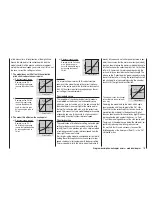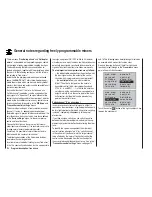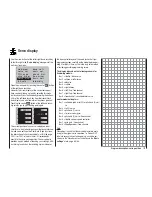
100
Program description: helicopter mixers – model helicopter
Adjusting the throttle and collective pitch curves
A practical procedure
Although the throttle and collective pitch control systems
are based on separate servos, they are always operated
in parallel by the throttle / collective pitch stick (except
when auto-rotation is invoked). The Helicopter program
automatically couples the functions in the required way.
In the
mx-16
HoTT program the trim lever of control
function 1 only affects the throttle servo, i. e. it acts as
idle trim (see “Digital trims” on page 40).
The process of adjusting “throttle” and collective pitch
correctly, i. e. setting the motor’s power curve to match
the collective pitch setting of the main rotor blades,
is the most important aspect of setting up any model
helicopter. The program of the
mx-16
HoTT provides
independent adjustment facilities for the throttle, collec-
tive pitch and torque compensation curves.
These curves can be defi ned using a maximum of fi ve
reference points. To defi ne the control curves all you
have to do is set individual values for these fi ve points in
order to determine each control curve.
However, before you set up the throttle / collective pitch
function it is important to adjust the mechanical linkages
to all the servos accurately, in accordance with the set-
up notes provided by the helicopter manufacturer.
Note:
The hover point should always be set to the centre
position of the throttle / collective pitch stick.
Idle setting and throttle curve
Note:
Since electric power systems by their nature require no
idle setting, it is not necessary to adjust the idle value.
However, the matching of the throttle and collective pitch
curve(s) must still be carried out as described here, in a
similar way to a glow-powered helicopter.
The idle setting is adjusted solely using the trim lever
of the Ch 1 function, with the throttle limiter closed, as
described in detail on pages 79 to 80.
Reference point 1 of the throttle curve defi nes the throttle
setting when the helicopter is in a descent, but without
affecting the hover setting.
This is a case where you can exploit fl ight phase pro-
gramming to use different throttle curves. An increased
system rotational speed below the hover point proves to
be useful in certain circumstances; for example, for fast,
steep landing approaches with greatly reduced collective
pitch, and for aerobatics.
The diagram shows a curve with
a slightly altered throttle setting
below the hover point at the cen-
tre of stick travel.
+100%
100%
OUTPUT
2
3
4
5
1
Control travel
Different throttle curves are programmed for each fl ight
phase, so that you can use the optimum set-up both for
hovering and aerobatics:
Low system rotational speed with smooth, gentle
•
control response and low noise at the hover.
Higher speed for aerobatics with motor power settings
•
close to maximum. In this case the throttle curve also
has to be adjusted in the hover range.
The basic set-up procedure
Although the
mx-16
HoTT transmitter provides a
broad range of adjustment for the collective pitch and
throttle curves, it is essential that you fi rst adjust all
the mechanical linkages in the model according to the
information supplied by the helicopter manufacturer, i. e.
all the system linkages should already be approximately
correct in mechanical terms. If you are not sure of how
to do this, any experienced helicopter pilot will be glad to
help you with the basic set-up.
The throttle linkage must be adjusted in such a way
that the throttle is just at the “fully open” position at the
full-throttle setting, or the speed controller of an electric
helicopter is set to full-power. When the throttle limiter
is at the idle position, the Ch 1 trim lever should just be
able to close the throttle completely, without the servo
striking its mechanical end-stop (quick throttle adjust-
ment using the “digital trim”: see page 40). With an
electric helicopter the motor should stop reliably when
the throttle limiter is closed.
Take your time, and carry out these adjustments very
carefully by adjusting the mechanical linkage and / or
changing the linkage point on the servo output arm or
the throttle lever. Only when you are confi dent that all is
well should you think about fi ne-tuning the throttle servo
using the transmitter’s electronic facilities.
Caution:
Read all you can about motors and helicopters, so
that you are aware of the inherent dangers and the
cautionary measures required before you attempt to
start the motor for the fi rst time!
With the basic set-up completed, it should be possible to
start the motor in accordance with the operating instruc-
tions supplied with it, and adjust the idle setting using
the trim lever of the throttle / collective pitch stick. The
idle position which you set is indicated in the transmit-
ter’s basic screen display by a horizontal bar in the
display of the Ch 1 trim lever’s position. Refer to page 40
Summary of Contents for mx-16 HOTT
Page 7: ...7 For your notes...
Page 37: ...37 For your notes...
Page 41: ...41 For your notes...
Page 45: ...45 For your notes...
Page 51: ...51 For your notes...
Page 55: ...55 For your notes...
Page 81: ...81 For your notes...
Page 103: ...103 For your notes...
Page 133: ...133 For your notes...
Page 141: ...141 For your notes...
Page 161: ...161 For your notes...
Page 173: ...173 For your notes...
















































